Aaah-ooooooooooh! Let me howl it to the world. I finally saw "the Pup," the companion to the Dog Star, Sirius. Here are some tips on you can see it, too.
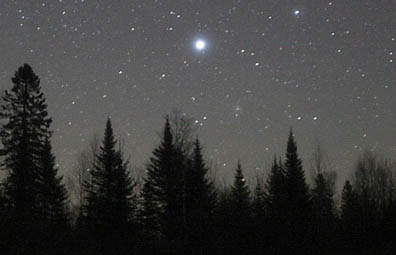
Bob King
Saturday night the phone rang. The words "Unknown Caller" glowed on the landline phone screen. "Has to be a spam call," I thought. Then I looked at the number and noted that it was local. Against my better judgement I lifted the receiver and answered a tentative "Hello ...?"
"Hi Bob," a familiar voice said. It was my friend Jim, a real human and fellow amateur astronomer.
"I've got Sirius B in the scope right now and it's really obvious. Would you like to come over?" Would I?! I told him I'd get in the car right now.
"Be there in two minutes," my voice trailed off.
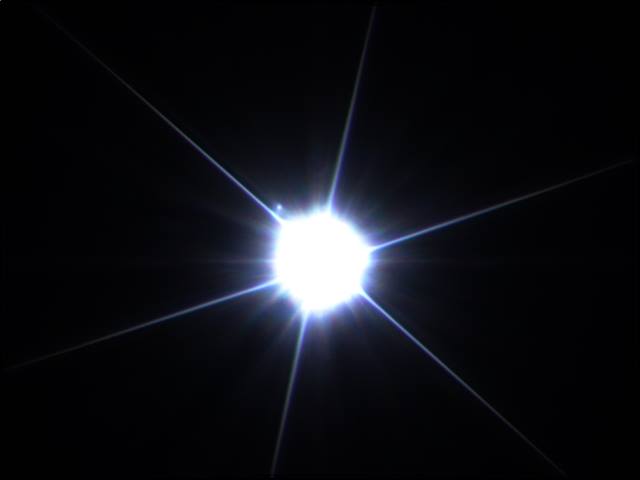
Gabriela and Fabio Carvalho
After explaining to my wife that despite untold hours under the sky, I'd never seen the Pup, the informal name for the white dwarf companion to Sirius, the sky's most brilliant star, I was out the door. I've tried finding it with a variety of telescopes ever since I was a teen, but the dwarf has always eluded me. Either it was too close to Sirius and swamped in its glare or jittery seeing mushed the two canines into a single unresolvable blob. Sirius never rises higher than 26° altitude from my home, and serene air is as hard to come by as a good January tomato.
Even in great seeing, the magnitude difference makes splitting the pair a worthy challenge. The Dog Star shines at magnitude –1.46 and the Pup at +8.4, a difference in brightness of 10,000 times. Why would anyone bother? Amateurs would! We bother a lot because we like to see real stuff with our own eyes. To witness how the universe is put together and even at times to see it fall apart.
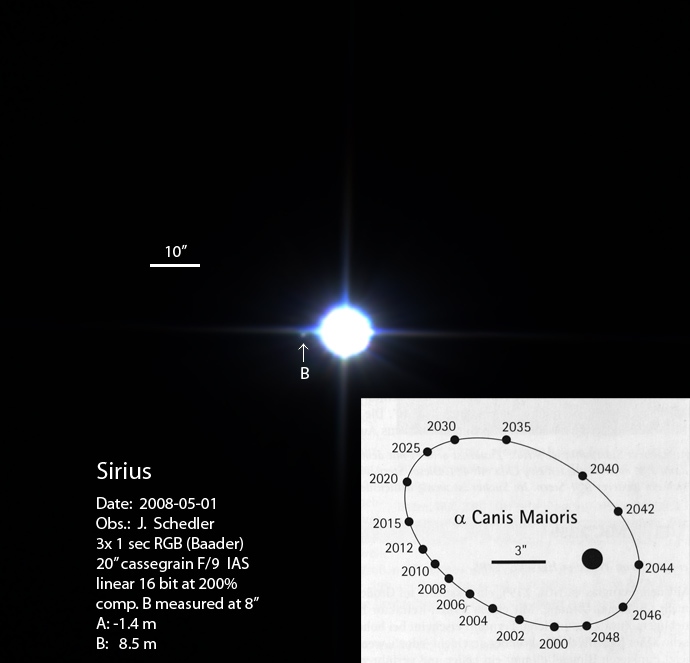
Johannes Schedler / panther-observatory.com
I arrived at Jim's place and stepped up to his 18-inch homemade Dob fitted with an eyepiece providing 300×. The air was calm, the sky partly cloudy, and the stars appeared as still as sleeping babies. I knew to look for Sirius B a short distance to the northeast of the primary. Jim described it as obvious and located just below a prominent diffraction spike sticking out like some luminous cactus spine due east of Sirius A.
OMG — there it was!
It took only a little effort to uncover this shyest of suns, but once seen, it was easily acquired again and again. For fun, we upped the magnification to 600×, and while the seeing degraded at bit, the white dwarf became even more obvious. It's one thing to read that Sirius A is 1.75 times larger than the Sun and 26 times more luminous, but when you see it next to Sirius B, a star 360 times fainter than the Sun and 400 miles smaller than the Earth, you begin to appreciate how radically different a white dwarf is from an average main sequence star.
I found it even more amazing to behold two stars that on average are only as far from one another as Uranus and the Sun, a distance of about 20 a.u. To see the pair is to sense something of the scale or our Solar System as seen from Sirius, 8.6 light years away.
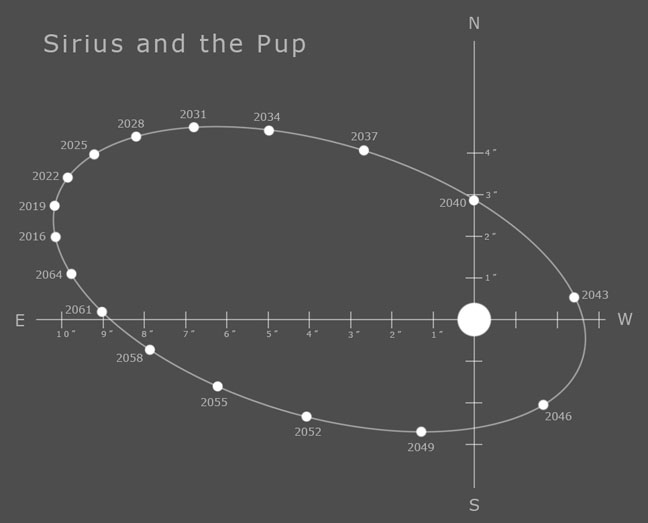
Jerry Lodriguss
While an 18-inch proved handy in making an astronomical wish come true — thank you, Jim! — a large scope isn't required to split these inseparables. I've seen reports of amateurs cracking them with 8-inch and occasionally even with 6-inch telescopes. The keys to success are these:
- Excellent seeing: Walk away and look at something else if Sirius shimmies and shakes in the scope. Check every clear night till the seeing allows.
- High magnification: You'll need at least 300× to get enough dark sky between the two stars to pry them apart. More is better!
- Knowing exactly where to look: Keep the orbital diagram featured here handy to know where to focus your gaze. If your reflecting telescope uses a standard spider mount for the secondary mirror, stars will produce diffraction spikes. Make sure when searching for Sirius B that one of those spikes doesn't block the star from view.
- Clever tricks: When seeking its companion, place Sirius just beyond the edge of the field or fashion a simple occulting bar for your eyepiece and tuck Sirius behind it. Both methods block the overbright star's ferocious glare, making it easier to coax out the fainter Pup.
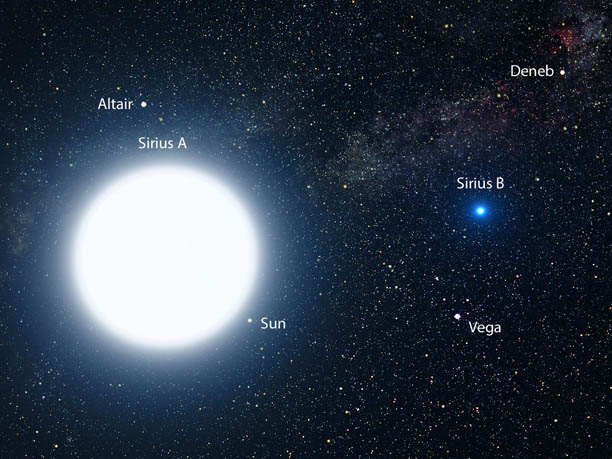
NASA / ESA / G. Bacon (STScI)
I thoroughly enjoyed seeing Sirius B, and now that I know what to look for, I hope to find it in my own 10-inch scope. After all, the timing is good. If you've never seen the Pup, it will be at or near maximum separation for the next few years. Take advantage of a stellar opportunity to see the most famous pair of dogs in the sky. Steady skies!
 26
26








Comments
Anthony Barreiro
March 29, 2017 at 6:17 pm
Congratulations, Jim and Bob!
You must be logged in to post a comment.
Bob KingPost Author
March 29, 2017 at 8:57 pm
Thank you, Anthony. I take it you've seen Sirius's companion, too.
You must be logged in to post a comment.
Anthony Barreiro
March 30, 2017 at 3:38 pm
No, not yet. A couple of years ago a friend saw the pup through an 11-inch schmidt cassegrain, and several other people saw it, but I couldn't. I suspect that either my eyeglasses or very mild cataract caused extra glare that prevented me from seeing it. I'll keep pestering friends with big scopes to try.
You must be logged in to post a comment.
David-Green
March 30, 2017 at 3:02 pm
Hi Bob. I'm just curious: When you mention apertures regarding seeing the Pup, I assume you are talking about reflectors. Would using a high-end refractor perhaps allow for seeing the Pup with less aperture? Thanks!
You must be logged in to post a comment.
Bob KingPost Author
March 30, 2017 at 3:05 pm
Hi David,
Yes, I think it would be possible, but I don't know what the minimum size might be. I suspect you'd see it now in a 6-inch refractor.
You must be logged in to post a comment.
Alan-Harris
March 31, 2017 at 4:54 pm
My own story of seeing "the pup" is worth repeating. Back about 1977 and again a year or two later, I was observing Saturn's satellites with the Mt. Wilson 100" telescope. In 1977, my goal was to monitor the brightness of Iapetus as it passed through the shadow of Saturn's rings, and in 1979/80 I was monitoring Janus and Epimethius at the time of the ring plane crossing. For both, I had build a coronagraph to eliminate diffraction and scattered light from the nearby intensely bright Saturn itself. On the first night of observation, I thought it would be a fun test to have a look for "the pup", so in the October morning with Sirius well up in the sky, I had a look. Needless to say, Sirius in a 100" telescope is, well, seriously bright. But there is was, more or less like the pictures in this article, and at about the same position angle, nearly a full orbit earlier. I was set up for photography but didn't take a picture, as I expect the dynamic range of the high contrast emulsion I was using would be totally saturated by Sirius before showing "the pup". But it was a memorable sight.
You must be logged in to post a comment.
Bob KingPost Author
March 31, 2017 at 9:57 pm
Great story, Alan! Thank you for sharing it. I'm trying to imagine seeing Sirius in a 100-inch scope. Ouch!
You must be logged in to post a comment.
March 31, 2017 at 5:18 pm
Within the last few years Sirius B was picked up with a Takahashi five inch triplet refractor from the Bay area in California. I have been trying with a 260mm (10.23 inch) Klevtzov catadioptric (Vixen VMC), but seeing has not cooperated yet.
You must be logged in to post a comment.
Bob KingPost Author
March 31, 2017 at 9:47 pm
Hi Eric,
Thanks for sharing your observation. That's quite a feat! That also answers the question another observer had about the possibility that a smaller aperture refractor might do as well as a larger aperture reflector.
You must be logged in to post a comment.
David Aucoin
March 31, 2017 at 7:50 pm
I have seen it not so much visually as I have behind the screen of my laptyop and a ZWO ASI224MC camera on my Nexstar 8se. I was able to detect the pup several times while imaging this past winter. I used an old trick, from way back in 1977, when Dennis DiCicco made a pentagram mask for the front of his C8 to be able to photograph the pup between the spikes of the mask. On several occasions, I have imaged the pup with this set up abd have images to prove I have seen it.
You must be logged in to post a comment.
Bob KingPost Author
March 31, 2017 at 9:44 pm
Hi David,
Thanks for mentioning Dennis's mask - I remember that now. An excellent method.
You must be logged in to post a comment.
April 4, 2017 at 10:40 am
Hi Bob,
Emanuel from Buenos Aires here... First time commenting on your site, but frequent reader of your posts. Thanks so much for sharing your knowledge with such casual language anyone can get the message, even non-english speaking amateurs like me!
Will be targeting the Pup with my 3-inch scope... hope to find something out there! 🙂
Thanks again for sharing!
You must be logged in to post a comment.
Bob KingPost Author
April 4, 2017 at 10:50 am
Thank you, Emanuel. And I hope you're able to see it. At least Sirius is much higher in the sky for you compared to where I live. It will be a challenge, but if you find the pup, please let us know. Good luck!
You must be logged in to post a comment.
Elvio
March 8, 2019 at 10:00 pm
Dear Bob: A year ago I took a picture of Sirius A and B.
I used a 12-inch Newtonian reflector, and approximately 200 x magnification by ocular projection- I used a canon DSLR (eos rebel 3Ti).
That was possible thanks to your directives in this section of S & T !!
Now I would like to share with you and your readers this photo, (if you want or it is possible) but I do not know how to upload it.
Thank you very much for your attention.
Elvio Alanís, Salta, (north of) Argentina
You must be logged in to post a comment.
Thomas Schutz
November 2, 2020 at 2:06 pm
Here's another Pup spotting report:
Could never ever manage to spy the Pup, but seeing was steady so I decided to give it another try. 100mm apo refractor, 211X, Sirius at about 30 deg altitude.
16 minutes trying, no luck.
Then I turned the scope to Castor (separation 5.3") to give me a better sense of image scale, and realized that I had been looking way too close in to Sirius. So I went back to Sirius and tried again. During instants of settled seeing I could just barely see it. I estimated the position angle as NE, then found the wonderful orbital diagram in your article above, and was totally psyched to see it corresponded.
Very challenging object! I was just staring at it directly in the central FOV, but in the future it would be interesting to play with the tricks mentioned above (edge-of-eyepiece, pentagram mask, occulting bar.)
You must be logged in to post a comment.
Bob KingPost Author
November 2, 2020 at 8:01 pm
Congratulations, Thomas! I know the joy of that observation. Excellent idea to use Castor to help you anticipate the Pup's separation from Sirius.
You must be logged in to post a comment.
Thomas Schutz
November 2, 2020 at 2:28 pm
Interesting article about the Pup's first reported visual detection in 1862:
http://adsabs.harvard.edu/full/1987JAVSO..16...34W
I first learned of the existence of the Pup a long time ago when, purely serendipitously while walking down the street, I saw a modest and forgotten-looking plaque on the side of an unremarkable building, stating that this was the location where Alvan Clark made the first visual sighting of Sirius B. A few years ago I returned to the location but the plaque was nowhere to be found.
Finally, I saw the Pup with my own eyes last night, after 35 years of intermittent attempts.
You must be logged in to post a comment.
Bob KingPost Author
November 2, 2020 at 8:02 pm
Thomas,
Thanks for the link. And you've got me wondering where that plaque disappeared to.
You must be logged in to post a comment.
Michael Teoh
January 20, 2021 at 11:16 pm
In Jerry's blog, he mentioned that the furthest separation was on 2019, instead of 2023. Which is true?
You must be logged in to post a comment.
Bob KingPost Author
January 21, 2021 at 12:31 am
Hi Michael,
Apoastron or greatest true separation occurred in 2019, but from our vantage point on Earth greatest apparent separation of 11.3" will occur in 2023.
You must be logged in to post a comment.
Zubenelgenubi 61
March 12, 2021 at 2:03 pm
I saw it in around 1981 with the 6" Fitz-Clark refractory at Washington University in St. Louis. In spite of trying many times over many years, I succeeded just once.
You must be logged in to post a comment.
Michael
March 18, 2021 at 1:45 pm
Hi Bob,
Someone in the Double Star forum on CN posted a link to your article. It is a very enjoyable read, thanks!
As it happens, I had never seen Sirius B until last week. I used the method where one places Sirius A just outside the field. You can see my sketch here:
https://www.cloudynights.com/gallery/image/117098-sirius-b-the-pup/
You must be logged in to post a comment.
Bob KingPost Author
March 18, 2021 at 3:31 pm
Hi Michael,
Thank you! And congratulations on your sighting. Isn't it great to finally find such an exotic star?
You must be logged in to post a comment.
Michael
March 18, 2021 at 5:43 pm
Yes it was. I tried three nights in a row but the first two nights the seeing was just too poor for success. I would advise anyone to have patience and wait for a night of decent seeing.
You must be logged in to post a comment.
retroformat
February 7, 2022 at 11:27 am
Bob, I've really enjoyed this post and the many excellent replies. I think I saw the pup this past Tuesday in a f/15 7" Maksutov. The tiny spot that I saw seemed to correspond in terms of angle (with respect to field stars) and separation. Last year I tried several times with a 10" SCT, using tricks like putting a fake spider on it (bicycle spokes), in order to bleed some of the primary's brightness into diffraction spikes, and also using a little 12mm kellner that I modified with an occulting bar. But I had no luck with those last year.
Last week's sighting was in unusually good seeing (I'm in central Virginia), where I was even observing diffraction rings around Sirius, something I had never seen before. I did not see an airy disk - the center was "flaming" - but I did see three of four (wobbling / shifting in and out of clarity) faint diffraction rings further out. And it is within those rings that I believe I saw the pup hiding. Echoing another's comment, I saw it much further away from the center of Sirius than I had expected (and been looking). I guessed that the diffraction rings were spaced at about 2 arc-seconds apart, and by this reckoning the Pup appeared about ten arc-seconds from Sirius, which would be close to correct.
Now I wonder, is the spacing of diffraction rings a function of telescope aperture? (or focal length? or magnification?). That's an interesting question because then one would want to choose an aperture (or focal length, etc.) to produce a diffraction pattern where the pup falls in-between diffraction rings, not right on top of a diffraction ring.
When I saw it, it appeared to be right on top of a diffraction ring - the same distance from the center of Sirius as one of its diffraction rings. Not optimal. My "detection" took the form of noticing that while all the diffraction rings were quite unstable, this one spot in the diffraction pattern would not darken - it was stable. I believe that was the pup.
You must be logged in to post a comment.
Andrew
February 26, 2022 at 10:52 am
Hi Bob,
I was trying to see the pup last year with a 14” SCT and failed.
This month (February 2022) I’ve been doing some variable star observations and last week I was aligning my finder scope using Sirius and my 8”LX90 SCT and looking at Sirius I noticed Sirius b shining back at me! I wasn’t looking for it and there it was!
Lesson learned, just relax and stop searching for it. Looking too hard becomes a barrier.
Now I’m looking at Sirius b every night when I pull out the 8”. At least this month the skies are good in Southern California, and the transparency has been nice lately.
Thanks for your help.
You must be logged in to post a comment.
You must be logged in to post a comment.